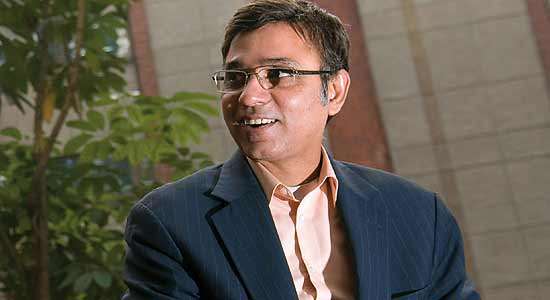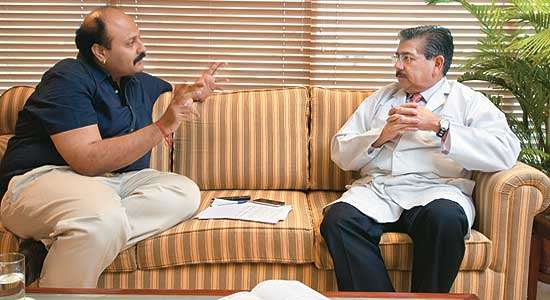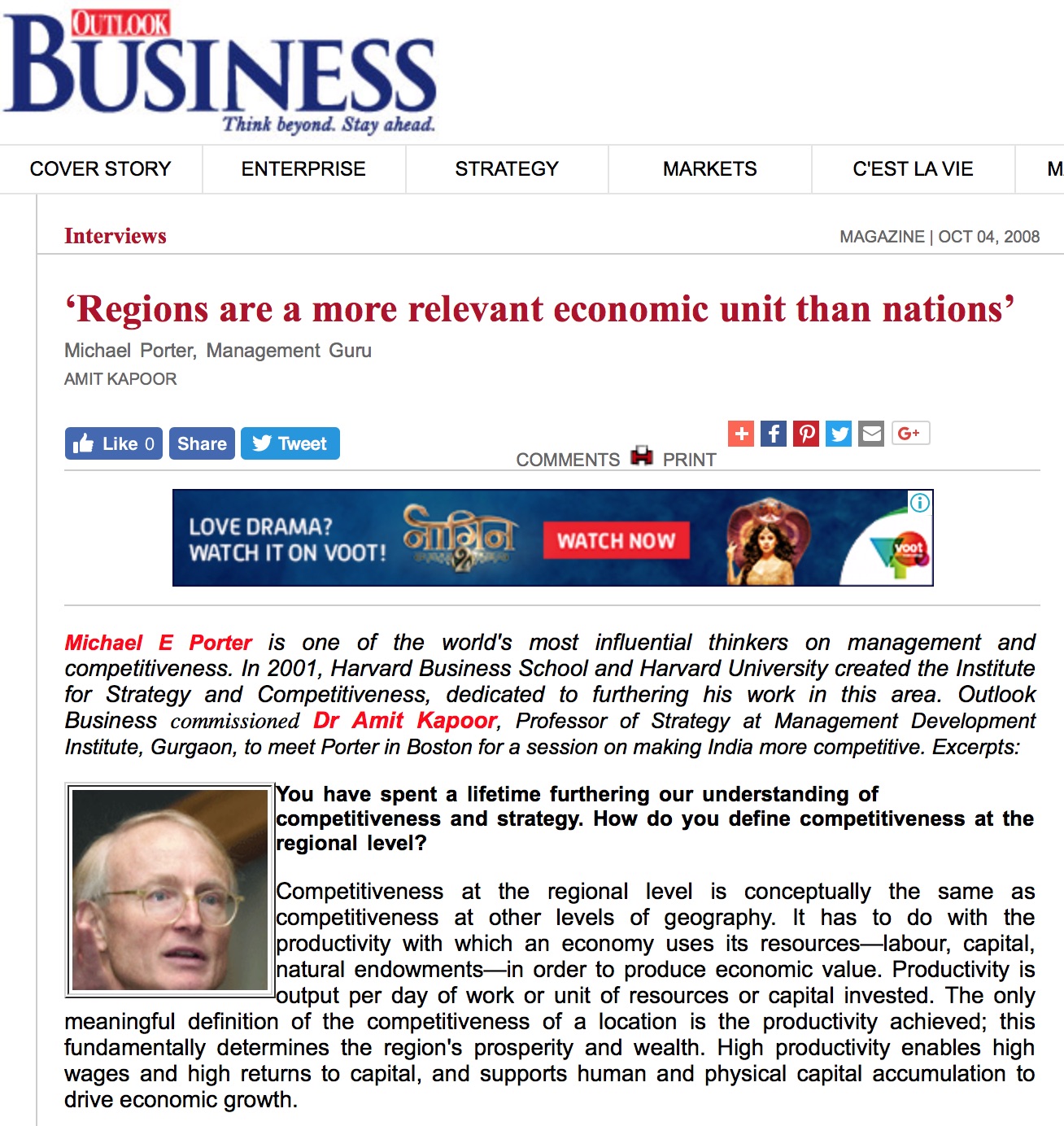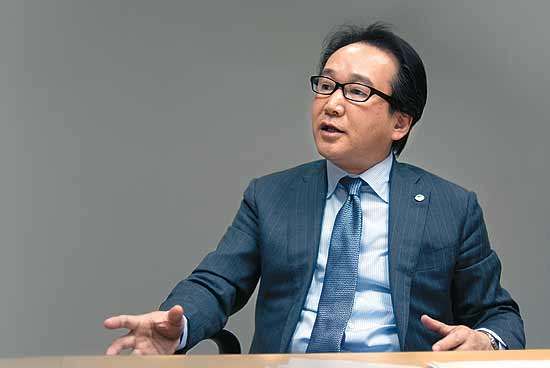A Vaidheesh, Managing Director, Johnson & Johnson Medical India explains to Dr Amit Kapoor of the Institute for Competitiveness, how the company’s business model can raise the standard of healthcare in the country.
What is strategy from your point of view?
Strategy primarily comes out of a vision. It is the “how” part of translating your vision into reality. First, you need to do a good job of having a well-articulated vision. The rest is all about how people convert the vision into a subset of strategies and execute them.
Many companies go down because they do not have a compelling vision. What do you think are the necessary characteristics of a vision?
The fundamental belief I have about vision is that you need to have an emotional connect to the purpose. People sometimes get verbose while writing the vision and come out with a set of statements that miss an emotional connect. An emotional connect is important and it generally starts with the leadership in the company and then percolates across the organisation through active engagement and involvement of all levels through an iterative process.
What is that emotional connect from your company’s perspective?
We fundamentally believe in being responsible to the customers we serve. Many people think that we are all about coming up with products for the mother and baby, but we are more than that. We believe in restoring the joy of life.
We have a very high level of emotional connect with the patients/ customers we serve. We respect the doctor-patient relationship and facilitate the process for the speedy recovery of the patient. Our vision is about raising the standards of care and that is why, I believe, we have gained the reputation of being a quality company in India.
Just because you serve a country with a large number of people who are poor doesn’t mean you need to provide poor quality of care. We make efforts to bring down costs, but not at the cost of quality.
4 Cs Model*
Competition
- Fought on value
- Segmental competition
- Medtronics (general diseases and orthopaedic trauma), Zimmer and Stryker (general surgery), Covidien (gynaecology)
- Chinese competition entering market
Customers
- Urban versus rural customer
- Demanding and well-read
- Power to buy health cover
Company
- Believes in being responsible to customers
- Built on strong vision
- Committed to raising standard of care in India
- High focus on patient outcome
Context
- Doctors unfamiliar with global standards of care
- Lifestyle diseases increasing
Strategy Demystified*
Industry Dynamics
- India has made significant progress in primary healthcare
- Challenges in secondary and tertiary healthcare
- Regulatory challenges for the government
Segmenting Strategically
- Operating in general surgery, cardiovascular, gynaecology, oncology, neurosciences and aesthetic surgery
Leveraging Unique Activities
- High quality, low cost products and solutions
- Focus on common man
- Working towards a low cost business model
Exploiting Tradeoffs
- Do not participate in low cost, low quality solutions
- No products/ solutions that harm the patient-healthcare provider relationship
Note: *Interviewer’s analysis
How do you, as a company, “restore the joy of life”?
Traditionally, from the age of Hippocrates, kindliness, concern and love of the art and science of healing are the qualities that were expected of healthcare community. When the patient reaches out to the healthcare system at the time of sickness, it’s a serious, critical moment. The question is, how do we support that critical moment with the healthcare providers in restoring the joys of life? We have a programme called the ”promise of healthcare”, wherein we believe that we have the responsibility to advance good healthcare through our actions as well as to work with others to help shape effective healthcare systems around the world that can serve the needs of the people.
India has various Standards of care ranging from islands of excellence to islands of nothingness.
You mentioned improving the standard of care in India. What do you think is happening in the country right now?
India is such a diverse country and you have standards of care ranging from islands of excellence to islands of nothingness. We have set up a training centre where we’ve trained over 30,000 doctors in basic surgeries. You see doctors trained in surgery, but many are unfamiliar with the global standards of care. We are going to inaugurate one more centre in Chennai, where we are going to train orthopaedic surgeons on advanced joint replacement surgery. We have partnered with the Tamil Nadu government on its below-the-poverty-line program and we will be doing knee replacements at a lower price for 10,000 patients under that programme.
It is the common people who require modern technology and the right care. If a poor person is unwell and out of a job, his entire family’s life comes to a halt. We can make a difference here, so that he stands up on his feet and starts being productive as soon as possible. A recent news report said almost 20% of people are affected by poverty because of health conditions. We want to contribute towards changing that. There are smart ways of doing this by having a different business model.
What is the business model you suggest?
Generally, there are two costs—conversion cost and interface cost. Conversion cost is relatively 20-30% of your total cost, while interface cost is about 70-80%. If by some innovation you can cut down the interface cost, you can bring down your total costs by a huge percentage.
For example, with digital technology, hospitals can directly place an order through an online system, and the entire supply chain is managed through a hub-and-spoke model, removing all distribution channels and also bringing in efficiency in the supply chain. By adopting something like this, you can easily cut costs by 30-40%. Though challenging, it is possible with the right environment.
So by reducing your costs, you are ultimately looking at providing products to the consumer at a lower price?
Yes. That’s the intention. Why should a consumer pay for the inventory-carrying cost? This is something we have learned from shampoo sachets sold in the 1980s in India. Every woman wants to wash her hair, but she doesn’t always have money to pay for the bottle, so she buys a sachet for Rs 1. If she were to buy a 50 ml bottle, the total cost base would be cheaper, but not all consumers can afford that. This is what CK Prahalad talked about in the concept of “poverty premium”. The poorer you are, the more premium you pay.
What is your view on poverty premium?
My understanding, from Prof Prahalad, is that the premium the person is paying is primarily for the inability to pay for the inventory (you cannot store and preserve the product). The fact is, poor people end up paying a premium for the same products. Consider mobile technology. Today, a poor man also has a mobile phone. They must be paying a premium for using it, but the fact is, it meets their needs. They have what it takes to pay for it and they can access it. The whole point is to figure out the process for the access.
Coming back to standards of healthcare, where do you think India fits in?
You need to split healthcare into three pieces—primary, secondary and tertiary. Barring a few alarming trends like infant mortality and maternal mortality, India has made significant progress in primary care, whether it is immunisation programmes, typhoid, cholera, dysentery or leprosy disease management… I think the challenge now is in secondary and tertiary care. Our economy is growing at about 9% and is likely to reach $2 trillion in five years. Lifestyle diseases are also coming up in a big way—diabetes, kidney failure, eye care, heart attacks…
What do you think is missing?
Lifestyle diseases are currently not a priority for the government considering the other challenges it faces. A large portion of the healthcare expenditure of 1% of the GDP goes to the National Rural Health Mission and other primary care.
The challenge now is in secondary and tertiary care. Lifestyle diseases are also coming up in a big way.
So this comes to about $10 per person.
Correct. It is meagre! It only takes care of primary healthcare. Even 2-3% [of GDP], in my opinion, will not cut any ice. You should be operating at least a minimum of 5-6% of GDP, which is what most developed countries like Canada spend. Japan is very good, at about 7%, but it is also a large economy.
If you ask me whether we will be able to deal with the cardiac issues arising in India, I doubt it. About 55% of the world’s cardiac deaths are going to come from India by 2015, and I am not sure whether we are adequately prepared to deal with this burden.
Is the mechanism absent in the healthcare system?
There is no apparent mechanism to deal with this. As a country we are making efforts, but I don’t think we have adequate number of well-trained healthcare professionals to deal with lifestyle disease issues. We are seeing one in five people in the country suffering from hypertension. With lifestyles changing dramatically, you’re going to see a lot of people suffering from stroke and other related diseases. These are all scary scenarios. I see the number of young people getting heart attacks increasing. I have spoken to some cardiologists in the recent past and they say that earlier one out of four cases in a week used to be a young person; now this has increased on an intraday basis!
What are your solutions to this?
First and foremost, knowledge-based awareness. About 80% of heart disease, stroke and diabetes, and 40% of cancer is projected to reduce through increased awareness and preventive measures. Once you create awareness, people can be motivated to stop smoking; they will start eating properly, stop eating junk food, learn stress management, start going to the gym, exercise…
So, essentially, we are sitting on one of the biggest healthcare markets in the world. Where is Johnson & Johnson Medical India positioning itself in this healthcare market?
We have set up institutes for doctors to learn various advance procedures like joint replacement surgeries, management peripheral vascular diseases, minimal access surgeries, etc.
As an example, when you do an open surgery, the patient is likely to be in the hospital for eight days, and morbidity and infection rates are high. When you perform minimal invasive surgeries, the patient can be discharged within 24 hours, provided the surgery is performed by well-trained healthcare specialists.
Similarly, we are also training professionals on doing laparoscopy-assisted hysterectomies, particularly safe uterus removal, with the support of experts. We are focusing on better technologies, better processes, better practices and, ultimately, better patient outcomes.
What are the main segments in which you will operate?
We are in the general surgery, cardiovascular, gynaecology, oncology and neurosciences, and infection prevention space. Recently, we have forayed in the aesthetic surgery space with breast implants, removal of neurotoxins, etc.
Will you further tap the beauty market?
What we call the aesthetic surgery space, yes. It is a unique segment. We are particularly looking at cancer patients who have had mastectomies.
This expands our capacity to provide physicians with products that can restore patients’ appearance, self-esteem and quality of life. But this sector will account for a very small portion of our turnover in India.
How do you think your consumers have changed over a period of time?
If you have money to pay for something, you start demanding quality and service. Today’s consumers, particularly urban consumers, are demanding and well-read. With shifts in digital technology, consumers come to the doctor well-prepared. There’s a lot of pressure on healthcare professionals to be well-prepared with an answer. With health insurance coming in, people have the power to buy their health cover. They challenge everything and ask for the best possible care.
How is this a challenge for you?
Well, it is an opportunity for us because that’s what we are committed to—raising the standard of care. Competition is not going to be poor quality competition, but good, healthy competition. It’s not going to be fought on price; it’s going to be fought on value.
How would you define this value?
People are going to demand outcomes. They’re going to ask questions. Healthcare economics as a domain is going to open up. You are going to see evidence-based health economics, clinical affairs; regulatory pathways are going to become far tougher, the government will focus on improving the regulatory system…
What kind of regulatory challenges will the government face?
First and foremost, you need to set standards. There is no nationwide accreditation policy, though NABH [National Accreditation Board for Hospitals] is making significant efforts. Currently there is no classification of providers based on outcomes. The government may have to pitch in and provide accreditation and classification through public/ private partnership. I don’t think the government has the necessary bandwidth. The healthcare industry will evolve.
In what way?
In healthcare, from low standard of care, it’ll evolve into some standard of care, and the ultimate destination is going to be the global standard of care. What is available in Japan should be available to everyone in the society. This is not going to happen overnight.
For example, I have come across people who go for an intestinal procedure where they use very low-cost/ quality electrocautery. The electrical charge is such that it can damage your intestine if it is not managed well! Going forward, we may need to set procedure protocols and standards.
It is also related to economic growth. Today India is at $1.2 trillion. Imagine that it becomes a $4 trillion economy in about 20 years. With the amount of money that people will have, we will not be satisfied with low standards of care. So the model could evolve with economic growth.
Who are some of the other players in the various segments you operate in?
Medtronics in the orthopaedic sector; Zimmer and Stryker in general surgery; and for gynaecology, Covidien. Companies from China will come here very soon.
What were some strategic choices that you made in India after understanding the local environment?
As a company, we do not participate in what I call low-cost, low-quality solutions. All our solutions have to meet a high standard of care and there is no compromise. Our challenge is primarily figuring out how to give the best quality at a reasonable price.
We have initiated an R&D set up in India towards coming up with solutions that are very specific to India. In fact, we’ve already developed a product called the One Touch Horizon Glucometer for the Indian market, which was developed in consultation with the doctors in India. It became so successful that we extended the idea to markets like the US.
Do you feel that India is going to be one big product creation factory for you?
It is an idea factory, and it may not necessarily take care of only India’s needs. Brazil, Russia, China and Africa will all benefit from what we do in India because the markets are similar with similar economic and social development.
What is leadership and change to you?
Let me comment on this in general. First and foremost, leadership has to be very genuine. There should be a clear vision, because leadership without a vision is meaningless. I personally like the 4E model of leadership of Mick Yates of leadervalues.com—envisioning, enabling, empowering and energising.
The values that guide our decision making are spelt out in our credo. In India, we contribute towards corporate social responsibility. I go and teach for about five days in schools. We are adopting a village in Madhya Pradesh where they don’t even have the facility for water, so we request our employees to volunteer and spend time there and help the villagers with rainwater harvesting. You can’t take over the role of the government, but you can help in supplementing its efforts.
CEOs across India speak on strategy and leadership, in an exclusive series developed jointly by Outlook Business and the Institute for Competitiveness. The StratSpeak interaction was published with Outlook Business on February 19, 2011.
























